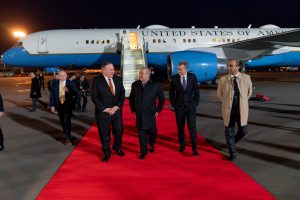One of the outcomes of high-level visits between countries of differing economic status is the financial assistance a richer country promises to provide. Oftentimes, the seriousness of cooperation between these countries is measured by the zeros at the end of assistance packages, whereby more zeros indicate stronger partnership and intentions. When it comes to Central Asia-U.S. relations, financial assistance packages from the United States have traditionally been lower compared to those provided by Washington to Afghanistan or the Caucasus.
U.S. Secretary of State Mike Pompeo visited Tashkent in early February to meet his counterpart, Uzbek Foreign Minister Abdulaziz Kamilov, and President Shavkat Mirziyoyev. He also participated in the latest round of the regional C5+1 meeting, which gathered the foreign ministers of the five Central Asian countries with the United States. During the U.S.-Uzbekistan bilateral meeting, Pompeo pledged $2 million in assistance to Tashkent. This amount taken alone looks meager compared to the amounts Russian or Chinese leaders pledged recently (China signed deals worth more than $10 billion in 2017 and Russian signed agreements for $25 billion in 2018).
However, in no way does this mean that the overall U.S. financial assistance package will be limited to the headline $2 million. According to Pompeo, in 2019 U.S. government projects in Uzbekistan amounted to $100 million (half of this amount was earmarked for education sector reform).
A closer overview of overall U.S. assistance to the region suggests that larger U.S. investments are conveyed through less direct assistance mechanisms. What appears under the category of “U.S.-government projects” is the smallest piece of the pie. The overwhelming amount of U.S. assistance comes via multinational development banks, such as the World Bank and others in which the United States is the largest stakeholder. Since the independence of the Central Asian states, that mechanism has provided $50 billion in loans, grants, and guarantees of the overall $91 billion the U.S. has spent in the region.
The other portion of the $91 billion in U.S. assistance came through a foreign direct investment mechanism, and amounted to $31 billion (Kazakhstan is the largest recipient in this category). The last mechanism, U.S.-government assistance, is where Uzbekistan’s $100 million in 2019 came and the newly pledged $2 million will be spent. Assistance under this mechanism is usually implemented by the U.S. Agency for International Development (USAID), and overall the United States has spent $9 billion via this mechanism.
The $2 million assistance that Pompeo highlighted in his trip, although small, indicates a new phase in U.S.-Uzbekistan relations. The first $1 million was pledged (pending congressional approval) for technical assistance for the development of Uzbekistan’s capital markets and another $1 million for trade and connectivity projects between Uzbekistan and Afghanistan.
Capital market reform in Uzbekistan is a recent development that has been spearheaded by the Agency for the Development of Capital Markets in Uzbekistan. In the words of its head, Otabek Nazirov, the development of capital markets in Uzbekistan will allow the country to attract foreign investments other than bank credits by selling bonds and stocks in the world market. He launched the sale of first $1 billion in bonds in 2019. For the hermit-like pre-2016 Uzbekistan, the transaction was a step toward a system with modern capital markets that will attract foreign investments, international players to the Uzbekistan market, and liquidity to banks.
The second $1 million U.S. investment aimed at developing trade and connectivity between Uzbekistan and Afghanistan is less clear, but the USAID office in Uzbekistan announced that the engagement could involve assessment of trade opportunities between Afghanistan and Uzbekistan, drafting legislation to facilitate trade relations, and training of students from Afghanistan. For Tashkent this project is a recognition of its role in the reconstruction process of Afghanistan.
Central Asian states have always been at the margins of U.S. interests, and U.S. direct assistance to the Central Asian states pales in comparison to the multibillion dollar investments from Russia and China. However, a broader look at other investment mechanisms with U.S. participation is necessary to understand the full nature of U.S. involvement in the region. As it turns out, major investment projects in infrastructure are funded by U.S.-dominated multinational development banks.
































